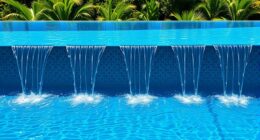Your energy bills change based on whether you choose a heat pump or resistance heat because heat pumps are more efficient in moderate climates, using outside air to warm your home and costing less to operate. Resistance heat, while cheaper upfront, burns more electricity, especially in cold weather, leading to higher bills. If you want to understand how climate, costs, and comfort influence your energy use, keep exploring the details behind each option.
Key Takeaways
- Resistance heat consumes more energy in cold weather, increasing bills, while heat pumps are more efficient in moderate climates.
- Installation costs are lower for resistance systems but may lead to higher long-term energy expenses.
- Heat pumps extract heat from outside air, reducing energy use and costs compared to resistance heating.
- Climate influences bill fluctuations; heat pumps are cost-effective in mild winters, resistance heating in very cold conditions.
- Upgrading to a heat pump can lower energy bills over time despite higher initial investment, due to better efficiency.

Are you trying to decide between a heat pump and resistance heat for your home? If so, you’ll want to consider how each option affects your energy bills and overall comfort. Resistance heat, which uses electric resistance elements, heats your home directly and is simple to install. However, it tends to be less energy efficient, especially during colder months, which means your bills can skyrocket when you need heat the most. On the other hand, heat pumps work by extracting heat from the outside air and bringing it inside, even in cooler weather. This process makes them markedly more energy efficient, especially in moderate climates, which can lead to lower energy costs over time.
Choosing between heat pumps and resistance heat impacts your energy bills and comfort levels.
When it comes to installation costs, resistance heating systems are generally cheaper upfront. They require less complex equipment and fewer modifications to your existing electrical system, making the initial investment lower. Conversely, heat pumps often have higher installation costs because they involve more sophisticated components and sometimes require additional work to optimize efficiency, such as upgrading ductwork or electrical wiring. Still, many homeowners find that the long-term savings in energy bills more than compensate for the higher initial outlay.
Energy efficiency is a vital factor when choosing between these heating options. Resistance heat converts nearly 100% of the electricity it uses directly into heat, but that doesn’t mean it’s the most economical choice. Because resistance heating produces heat at a constant rate regardless of outdoor conditions, it can consume a lot of electricity during cold snaps, leading to high bills. In contrast, heat pumps leverage outdoor air to generate heat, making them far more efficient in mild to moderately cold weather. Even in colder climates, modern heat pumps can operate efficiently, especially if you invest in models designed for low temperatures. Additionally, advances in noise reduction technology have made modern heat pumps quieter and more comfortable for indoor living.
Your decision will also depend on your climate and how often you need heating. If you live in a region with mild winters, a heat pump might be your best bet for saving money and reducing your carbon footprint. But if you experience extremely cold weather regularly, resistance heat could be more reliable, despite its higher running costs. Keep in mind that some homeowners use resistance heat as a backup or supplemental source, which can be a good compromise.
Ultimately, your choice hinges on balancing upfront costs, energy efficiency, and long-term savings. While resistance heating might seem more affordable initially, the ongoing energy expenses can add up quickly. Heat pumps, although more costly at first, often pay off over time through lower energy bills and greater efficiency, making them a smart choice for many homeowners aiming to reduce costs and environmental impact.
Frequently Asked Questions
How Do Outdoor Temperatures Impact Heat Pump Efficiency?
Outdoor temperature directly affects your heat pump efficiency. When it’s milder outside, your heat pump works more efficiently, saving you money. But as temperatures drop, the heat pump has to work harder to extract heat, reducing efficiency and increasing your energy bills. You’ll notice this especially during cold snaps. To keep bills manageable, consider a backup heating system or upgrading to a model designed for colder climates.
Can Resistance Heaters Be More Cost-Effective in Certain Climates?
Yes, resistance heaters can be more cost-effective in certain climates, especially when temperatures drop below a heat pump’s ideal range. In colder regions, resistance heating offers reliable, consistent warmth, making the cost comparison favorable since heat pumps may need auxiliary heat, increasing expenses. If your climate is extremely cold or has high energy costs, resistance heaters might be a better choice financially, ensuring comfort without frequent repairs or efficiency drops.
How Do Maintenance Costs Compare Between Heat Pumps and Resistance Systems?
You’ll find that heat pumps generally have higher maintenance expenses due to their complex components, but they usually require less frequent repairs. Resistance systems tend to have lower maintenance costs initially, but parts may wear out faster, leading to more frequent repairs over time. Overall, your choice depends on balancing upfront costs with long-term maintenance expenses and repair frequency, which can vary based on climate and usage.
What Is the Lifespan Difference Between Heat Pumps and Resistance Heaters?
You’ll find that heat pumps generally last 10 to 15 years, while resistance heaters can last around 20 years. This difference in system durability impacts replacement costs, with heat pumps potentially needing replacement sooner. Regular maintenance extends their lifespan, but ultimately, resistance heaters tend to be more durable due to fewer moving parts. Consider this when evaluating long-term expenses and choosing the system that fits your budget and needs.
Are There Government Incentives for Installing Heat Pumps?
Yes, you can benefit from government incentives and rebate programs when installing a heat pump. Many local, state, and federal initiatives aim to encourage energy-efficient upgrades, offering financial assistance to reduce installation costs. Check with your utility provider or government websites to find available programs. Taking advantage of these incentives can make switching to a heat pump more affordable and help you save on energy bills over time.
Conclusion
Choosing between a heat pump and resistance heat is like picking between a gentle breeze and a blazing fire—you get to decide how warm you want to feel. Heat pumps sip energy like a fine wine, keeping bills low and comfort high, while resistance heaters burn bright and costly. So, think of your energy choice as planting a seed for your home’s future—smart, efficient, and ready to flourish, no matter the season.









